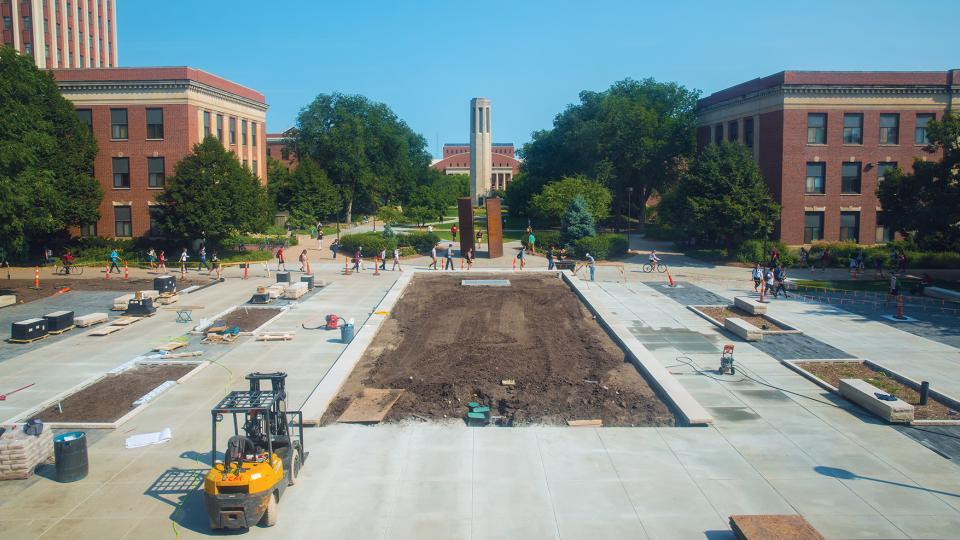
The beauty of the new Love Library Learning Commons plaza is more than just skin deep.
While part of a larger University Libraries project designed to offer 24/7 study space and encourage campus collaborations, the plaza is also an example of how the University of Nebraska–Lincoln is working to reduce the impacts of stormwater runoff.
"Where stormwater runoff was once considered a nuisance and diverted downstream, it is now looked at as a resource to be retained and used," said Liza Garrett, an environmental specialist with UNL's environmental health and safety department. "The Love Library project reflects this new paradigm in how the university approaches stormwater management."
Beneath the plaza's turf, concrete and specialized pavers are three sustainable water management tools, including bioretention soils (a soil mix designed to absorb runoff water while allowing plant growth); silva cells (a pavement system that supports tree growth); and bioswales (landscape elements that assist with drainage). The system can handle up to 2,900 cubic feet of rainfall that otherwise would be directed to area stormwater systems.
"The goal is to use these green, low-impact infrastructures to mimic the natural hydrologic cycle, treating and retaining rain for use on the site where it falls," Garrett said. "By reducing the amount of rainfall diverted into stormwater conveyance systems, these methods allow the university to help reduce erosion and pollution in area streams and waterways. They also help relieve pressure on the stormwater systems and reduce the chance of flooding in communities downstream."
UNL's commitment to managing stormwater is rooted in provisions within the university's landscape master plan and its state permit to maintain a small municipal separate storm sewer system (SMS4). The permit, issued by the Nebraska Department of Environmental Quality with authority from the Environmental Protection Agency and the Federal Water Pollution Control Act of 1972, allows entities to develop a phased approach to regulating stormwater discharge.
"The permit primarily relates to regulating runoff through the implementation of best management practices in storm water management," said Emily Casper, campus landscape architect. "To maintain the permit, we must make a good faith effort toward managing the quality and quantity of our stormwater."
UNL has held its SMS4 permit since 2008 and is starting its phased approach to regulating stormwater discharge. The university's initial goal is to capture and reuse the first half-inch of every rainfall event. Per requirements of the SMS4 permit, that total will increase gradually over time, Casper said.
To help achieve the goal, the university is incorporating stormwater management tools into campus construction projects. Current construction integrating methods to manage rainfall includes the new veterinary diagnostics center on East Campus.
Existing campus structures that have stormwater management systems in place include Memorial Stadium, Morrison Center and the 19th and Vine streets parking garage.
Garrett said future projects would focus on methods to capture and filter runoff from campus rooftops, roads and parking surfaces.
"Those are areas where the university can have the greatest impact on capturing runoff water and filtering it naturally through bioretention soils and other best management practices," Garrett said. "Moving forward, we need to use methods that are practical and site-specific to make the greatest impact.
"And, by developing and following best practices, the university has huge potential in becoming a leader in stormwater management for the entire state."
— Troy Fedderson, University Communications